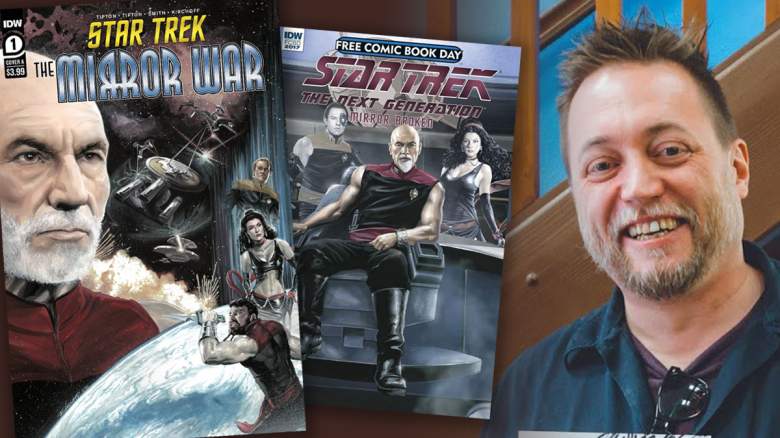
Courtesy of J.K. Woodward J.K. Woodward and his art
Between 1967 and 2021, there have been more than 500 comic books published featuring “Star Trek” adventures (the actual number is 518, according to Heavy’s calculations). While that is not as many as the 800 episodes of the various television series through the years, it is a massive collection of primarily unique stories. These comics were produced by industry giants, Marvel and DC, and other independent companies, like Gold Key and Malibu.
Even in the digital era, the world of “Star Trek” comic books is going strong. This is thanks to new titles created at IDW Publishing. This company has held the rights to the franchise since 2006 and has created over 100 different issues of Trek and even some crossovers. IDW even stepped in to publish “Star Trek II: The Wrath of Khan” after Marvel and DC passed on the opportunity.
Star Trek The Next Generation: Mirror Broken #0
Among the most popular of the IDW “Star Trek” comics was the Mirror Wars, which featured a look at the characters from “Star Trek: The Next Generation” in the Mirror Universe. That was something that never happened on the series or in the four feature films which followed. Getting to see an evil Captain Jean-Luc Picard (Patrick Stewart) was a wish by TNG fans in the early 1990s — the “Mirror Universe Collection” delivered that wish.
Artist J.K. Woodward worked with writers Scott and David Tipton to extend the Mirror Universe to Picard’s era. Heavy spoke with Woodward on how their comics filled in the gap left by the television series.
“I designed the characters in the uniforms for CBS directly for a style guide they were creating for the Mirror Universe,” said Woodward. “So long before it was ever considered a comic, I designed many of the characters.”
“But as the Tiptons came on, we were doing the comic,” said Woodward. “They, of course, contributed a lot more to it. In fact, we’d have these brainstorming sessions where we’d collaborate and come up with things.”
J.K. Woodward at NY Comic Con in 2011
“The initial idea of making the buff sleeveless, the goatees… these are things that were already established as tropes from ‘The Original Series,’” said Woodward.
While the world of “Star Trek” consists of the most beautifully designed look at humanity’s future, Woodward creates his look the old-fashioned way — by painting. Unlike many contemporary comic artists, Woodward does not start with a computer. Much like artist Alex Ross, who is well-known for his Marvel and DC projects, Woodward paints on gouache on hot press cotton. He has considered testing out an all-digital workflow, which would mean using an iPad and Apple Pencil.
This technique makes things more challenging for Woodward, especially regarding ships. But, as he said, the art style lends itself to incredibly accurate portraits of the actors from the shows.
Unlike Ross, Woodward has not worked for Marvel or DC, except for an issue of “X-Men Origins: The Beast.” Woodward considers himself lucky to be working in comics on a franchise he’s loved since he was seven years old.
J.K. Woodward, Star Trek Comic Artist
“I was watching ‘The Original Series’ in syndication,” said Woodward. “Then it was the movies, and I was a fan of those. Then ‘Next Generation’ came, as I was in high school.”
“I’ve been following every iteration of ‘Star Trek’ as it’s come out,” said Woodward. “And I’m in a major rewatch or two, which helps with the art. But ‘Star Trek’ was something I’ve always wanted to work on. I’d make a great deal more money working in superheroes, but I enjoy science fiction.”
Woodward said lately he’s been working on covers for various IDW “Star Trek” comics and has his own series, which he’s also working on.
Among the other notable Trek-related works Woodward has produced are the recent “Star Trek Book of Friendship” and a comic series based on Harlan Ellison’s original script for “The City on the Edge of Forever.”
When asked if there was one dream project that he could work on in the “Star Trek Universe,” Woodward responded that he’s already done it:
“ I like to do things they would never do on television,” said Woodward. “And that is bringing in cast crossing over cast from different times. I loved the idea the Tiptons did, called the ‘Q Conflict.’”
“I did this beautiful cover that had everybody in ‘Star Trek’ at the time, sans ‘Discovery,’ that mixed everyone together. All these gods were playing [the characters] like chess pieces. There’s no way you could do it any other way.”
READ NEXT: ‘Star Trek’ Fans: Please Do Not Spoil ‘NOPE’ for Everyone Else
Comments
Behind the Scenes With Artist J.K. Woodward and the “Next Generation” Mirror Universe